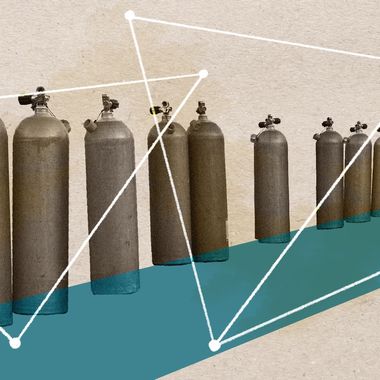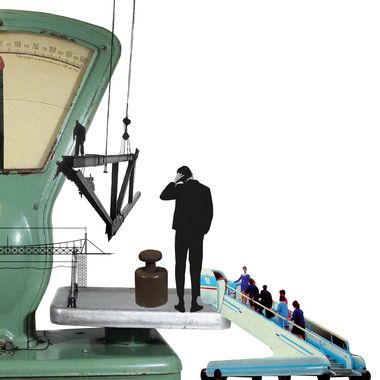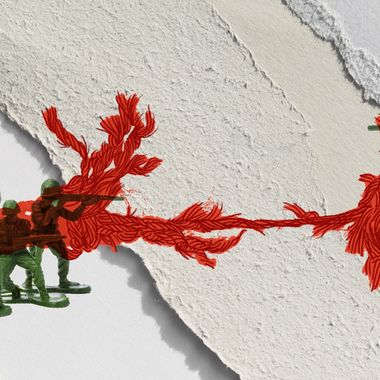Fri Mar 05 2021 · 8 min read
From Conflict Manager to Silent Observer
The EU’s Role in the South Ossetian and Nagorno-Karabakh Conflicts

By Anna Barseghyan

Illustration by Armine Shahbazyan.
The 2020 Artsakh War and its aftermath has shifted the geopolitical reality of the South Caucasus. The war put to the test long-held assumptions about the roles of neighbors and global players in the region. Some maintained and reinforced their significance and role in the region, some raised their importance and some were just invisible. Unfortunately, the European Union (EU) found itself in the latter group during the most severe hostilities to take place in its Eastern Partnership neighborhood. There were some weak and toothless statements made, parliamentary discussions held and humanitarian aid provided. Considering the EU's growing influence in the Eastern Partnership region, however, expectations were much higher.
After almost three months, on February 13, 2021, there was a joint statement by the Chair of the Delegation for Relations with the South Caucasus MEP Marina Kaljurand (Estonia-S&D), the European Parliament's Standing Rapporteur on Armenia MEP Andrey Kovatchev (Bulgaria-EPP), and the European Parliament's Standing Rapporteur on Azerbaijan MEP Željana Zovko (Croatia-EPP) where they called on the sides to the conflict to "reaffirm clearly and publicly their willingness to re-engage in the process led by the Minsk Group Co-Chairs and founded on the group's Basic Principles that they agreed to, reflecting the Helsinki Final Act principles of non-use of force, territorial integrity and the equal rights and self-determination of peoples.” During the war, and especially the ceasefire negotiation processes, two of the Minsk Group Co-chairs, the U.S. and France, were not able to impose peace. That left most issues to be decided between Russia and Turkey, a dangerous dynamic for Armenia. The European joint statement mentioned that negotiations on a lasting settlement of the Nagorno-Karabakh conflict and the region's future legal status remain as indispensable as ever. As most other issues had been resolved without the involvement of the EU, the status of Nagorno-Karabakh remains the only open door for the EU to re-enter.
The South Ossetian Case
When Russia invaded Georgia in 2008 to intervene in the South Ossetian conflict, the involvement of the EU in the mediation process was an impressive step toward declaring its solid presence in the region. Since the 2004 enlargement, which made the EU an immediate neighbor of Russia, regional conflicts and instabilities in the neighborhood became direct threats to the EU's security. The EU's Common Security and Defence Policy (CSDP) is one of the EU's sore points. However, since the establishment of the European Neighborhood Policy in 2004, the EU's engagement in security issues has had an evolving dynamic. Prior to 2008, the EU's actions were mainly built on the basis of soft power instruments, such as contributing to reforms, democratization and stabilization of the region. However, there was a lack of interest in widening the security agenda and playing a significant role in traditional security issues and crisis management.
The 2008 South Ossetian War lasted for five days between August 7 and 12, and created the perfect opportunity for the EU to enter the region and increase its political weight in the area. Until 2008, the EU engaged in these regional conflicts within the framework of other organizations, but 2008 changed that. During the war, President Nicolas Sarkozy of France, which held the rotating EU presidency at the time, sent a mediation mission after both NATO and the OSCE showed reluctance to answer Georgia’s appeals for mediation. It was perfect timing for the EU, and especially for Sarkozy, showing that French-led EU diplomacy was viable, and France as the head of the rotating presidency of the European Council was able to be a decisive player in the Neighborhood. It made up for the "failure" regarding creating a Mediterranean Union in the Southern Neighborhood. Sarkozy personally led the mediation process and travelled to Moscow and Tbilisi to assure a prompt end to hostilities and a workable agreement.
As a result, a six-point ceasefire agreement was signed. The EU proved itself as an active regional actor that can mediate in issues that previously were left up to Russia's sole discretion. At the same time, we believe that it was the result of a mutually-beneficial bargain between the EU and Russia aspiring to consolidate its reputation in the region, which has solved its primary strategic goals in the area.
However, a few things became clear. First, the EU’s energy policy sought to reduce dependence on Russia, and subsequently reduce Russia’s leverage. Second, Russia would no longer hesitate to engage militarily if it deemed its interests to be at stake. And third, the continued presence of "frozen" conflicts in the neighborhood was an avenue for Russia to justify military engagement.
After the war, the negotiation process was delegated to the OSCE, which created the Geneva talks platform involving the EU, the OSCE, the UN and the U.S., alongside the parties to the conflict, Georgia and Russia, and later Abkhazia and South Ossetia. Later, the UN and the OSCE’s mandates were not renewed, leaving the EU as the only conflict management actor. Moreover, the EU took on a mandate in September 2008 to launch the EU Monitoring Mission (EUMM) in Georgia, an unarmed civilian monitoring mission.
Over 200 civilian monitors were sent by EU Member States to contribute to the stabilization of the situation on the ground. Thus, the EU has fully entrenched itself as a conflict manager and security actor between Georgia and Russia.
A Differentiated Approach
In contrast to its approach to Nagorno-Karabakh, the EU has adopted a non-recognition and engagement approach in South Ossetia and Abkhazia. The EU justified this approach by its wish to counterbalance Russian influence in these two non-recognized republics. It should be noted that the EU has always taken a selective approach toward the conflicts in the post-Soviet space. For instance, Transnistria, Abkhazia and South Ossetia receive financial assistance from the EU, but Artsakh never did.
The EU has allocated funds to Abkhazia since the mid-1990s. During the nine years from 1997-2006, Abkhazia received €25,000,000 in financial support. In 2005, the European Commission financed the reconstruction of important infrastructure, such as the Inguri Hydro Power Plant.
The EU also provided significant humanitarian aid to Abkhazia. Prior to 2008, the EU was the main donor to support the needs of conflict-affected persons in South Ossetia and Abkhazia.
In 2007, the EU donated €4 million to the Georgia-Abkhaz conflict zone. This program was intended to improve the living conditions of the people in Abkhazia, with the main emphasis on civil society support. The three main elements of the program were:
-
Reconstruction of basic infrastructure (such as healthcare facilities, schools and drinking water supply) – UNDP (United National Development Programme);
-
Income-generation and community-based projects – UNHCR (United Nations High Commissioner for Refugees);
-
Shelter assistance, durable housing solutions for Internally Displaced persons (IDPs), returnees and the local population – UNHCR.
Even after the war in 2009, the European Commission implemented programs such as Regional EC programme for the protection of children in conflicts, Community Stabilization for IDPs, host communities and returnees (€1 million), community support for children and young people in Abkhazia (€1 million).
The assistance to South Ossetia is humbler. For the period 2006-2008, the EU contributed €2 million for further rehabilitation activities under an OSCE-led multi-donor program. After the 2008 war, the EU initiated a rehabilitation program mainly concentrated on schools. After the August 2008 fighting, the EC supported a small-scale project to develop an early warning mechanism in the areas adjacent to South Ossetia. With ECHO (European Civil Protection and Humanitarian Aid Operations) funding, the Halo Trust implemented a program for the removal of mines and UXOs (unexploded ordnances) from an area of 4,300 hectares in Shida Kartli, which was completed in December 2009. In total, from 2009-2011, the EC spent more than €1 million on the projects in South Ossetia.
The EU also tries to contribute to the creation of civil society in South Ossetia. From 2009 to 2017, the EU spent around €399,000 to support the creation of a strong civil society in Abkhazia: educational programs on creating a strong legal and stable society, programs on the implementation on international standards in human rights and justice in Abkhazia, youth civic participation, as well as providing psychological support to vulnerable people.
Another program called “Confidence Building Early Response Mechanism” has run since 2010. The €4 million fund was established to support immediate and concrete small-scale project initiatives that sought to have a demonstrable impact on confidence building within and across conflict divided communities in and around Abkhazia and South Ossetia.
In contrast, the EU's engagement in the Nagorno-Karabakh conflict was quite limited both before and after the 2020 Artsakh War. One of the rare initiatives was founded by the European Instrument for Stability in June 2010 to create a consortium of international NGOs to carry out dialogue work with Azerbaijanis and Armenians, including in Nagorno- Karabakh. The European Partnership for the Peaceful Settlement of the Conflict in Nagorno-Karabakh (EPNK) program supports the organization of dialogue meetings and media projects between various local stakeholders—including women, youth, journalists and scholarly communities. The partnership was a European civil society initiative with five member organizations: Conciliation Resources (UK), Crisis Management Initiative (Finland), International Alert (lead agency, UK), the Kvinna till Kvinna Foundation (Sweden) and LINKS (UK/Netherlands). The program lasted almost nine years and ended in 2019.
During the 2020 Artsakh War, humanitarian aid was allocated to Nagorno-Karabakh for the first time ever. On October 5, the EU allocated initial funding of €500,000 to help EU humanitarian partners, such as the International Committee of the Red Cross (ICRC), provide health support, medical equipment, food packages and other essential items to several thousand people. On October 30, the EU allocated €400,000 in humanitarian aid to cover the most urgent needs of civilians affected by the conflict in and around Nagorno-Karabakh. Later, on November 19, the Commission announced an additional €3 million in humanitarian support to ensure critical assistance to the civilians most affected by the conflict in and around Nagorno-Karabakh. On February 18, another €3 million was allocated to deliver food, shelter, winter items, health services and psychosocial support. Of course, every form of assistance in such tough times is much appreciated and contributes greatly to restoring basic life necessities.
The 2008 South Ossetia War and the 2020 Artsakh War offer two cases where the EU has demonstrated two totally different approaches - from conflict manager to silent observer. The importance of the EU has faded in the region; however, there remains room to re-engage. The status of Artsakh has not yet been resolved and Europe has taken initial steps in this direction with the French Senate motion.
also read
Southern Gas Corridor Brings Azerbaijani Gas to the EU
By Anna Barseghyan
The operation of the Southern Gas Corridor raises the geopolitical significance of Azerbaijan and Turkey, contributing to the further isolation of Armenia from regional projects. The EU seems to limit its concern about human rights violations and war crimes in Artsakh to mere lip service.
Is Armenia Expendable to the EU?
By Kristine Gasparyan
The EU’s weak stance and incapacity to act during a time of great need for the Armenian people still reverberates. Today, Armenians are asking themselves if they can afford to trust the EU again.
Can Trade Prevent War?
By Artin DerSimonian
Given the growing sense of global multipolarity and the apparent twilight years of the American-anchored liberal international order, Armenia cannot solely rely on friends and allies around the globe to ensure its survival. A more realistic approach is necessary.
Understanding the Region
Territorial Conflicts in the Caucasus
By Karena Avedissian
The dissolution of the Soviet Union, despite the mostly peaceful nature of the process itself, was followed by significant conflicts in a number of the newly independent states. Karena Avedissian looks at the territorial conflicts in the Caucasus.






